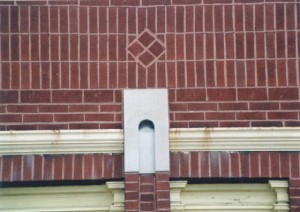
I was talking with my friend Eric Buddington the other day at the Bean. The subject turned to what is often called street art. Eric said he likes to create spontaneous art in public places. For example, on a recent trip out west, he gathered some leaves under a tree and put them in little piles in an artistic way. He said, “I don’t know if anyone noticed it, but the value of this kind of art is that it rewards the people who pay attention.”
Woody Allen once said, “Eighty percent of success is just showing up.”
If success means having a rich and satisfying life, then I say, “Eighty percent of success is paying attention.”
A few weeks ago, I had a wonderful day in North Adams. It was the kind of day I wish I could take out a subscription to, so I could find at least one like it in my mailbox every month.
It started with my usual early morning drive from Florence, which takes me on Route 9 along the Westfield River, up Route 8A through Savoy, down Route 116 to the Gulf Farm, over Burlingame Hill (I call it the cow path), and finally across East Road, until it turns into South Church Street near McCann School. It’s a one-hour trip I have taken nearly 200 times since I moved from Connecticut to Florence several years ago.
For a writer and photographer who depends on paying attention, this ride never gets old. Sometimes it takes me an extra 30 minutes, because I am always stopping or turning around to take a picture of something I never noticed before, or something familiar, but from a new angle or under a different sky.
When I got to the Bean, I hung out with my old-timer friends Tony Talarico, Carl Robare and Bob Field. We sat at our favorite table – the big one by the front window. Pretty soon, owner Audrey Witter came in with her daughter Hannah, who will be three years old in August. Little Hannah piled her collection of dolls and toys into a colorful miniature shopping basket, wheeled it up to the table, and joined us. For a good 45 minutes, she became the city’s youngest old-timer, as she commanded complete attention from her elders. Someone remarked, “One of God’s greatest gifts is in the eyes of that child.”
Several times, she grabbed Carl’s hand and led him off in no particular direction. When she reached a satisfactory spot, Hannah got Carl to help her empty all the contents of the shopping basket onto a nearby table. As soon as that was done, she decided she wanted it all back in the shopping cart again. This went on long enough to prompt one person to yell out, “Hey, Carl. Do you want me to call your wife and tell her you won’t be home till this evening?”
When Hannah finished with Carl, she started on me. So I followed her to the other front window, where she persuaded me to put all her stuff up on the counter. Then I lifted her up and sat her down on the counter, too. She turned around and stared out the window with her dolls and got a few waves from pedestrians. Over at another table, Ziggy and Mike and Fran looked on with grandfatherly eyes.
A few minutes later Eric came in with his violin and joined Tony Pisano and his guitar at a table toward the back and slipped quietly into a jam session of Appalachian fiddle tunes and Irish reels. This goes on several times a week at the Bean; and even if most patrons don’t seem to notice, the warm spontaneity of this music rewards the people who are paying attention.
When Audrey finally left to take Hannah to the babysitter, I looked at Carl and said: “I’m so glad I came over this morning. I wouldn’t have missed this for the world.”
For the whole time, I was focused intently on these events and the people in them, as if watching a movie. Too often, things like this happen around us, and we don’t even take the time to notice. But paying attention is what I like to do, and I was rewarded. It got me to thinking that we don’t pay enough attention to the youngest and the oldest among us.
A while later, I was wandering around Main Street with my camera. After all the articles and talk about the new redevelopment for 85 Main Street, Hoosac Bank, and J.J. Newberry’s, I felt I needed to take some pictures, especially of Newberry’s. If all goes according to plan, the rear portion of the building will be demolished to make way for parking and an entrance way to a drive-in window for Hoosac Bank.
I have taken many pictures of Newberry’s over the past five years (one of those pictures is the cover of my new book), and I never get tired of looking at that charming brick façade and the red sign with the missing letters. As I sized up the building – front, back, alley – through my camera lens, my eyes picked up little things I hadn’t caught before: a few bricks fashioned into a diamond shape, an interior wall on the third floor illuminated by a ray of sunlight, a thoughtful piece of graffiti in the alley, the faint outline of the missing “C” and “O” at the end of the sign, and the missing “B” on the sign facing Center Street.
It wasn’t long before I attracted a small crowd of curious onlookers, many of them the bus riders who populate that area almost continuously every day. A few passively moved aside, worried that they might be in the way (they weren’t). A few more offered some nostalgic observations:
“I remember the candy case right behind the lunch counter, and the smell of popcorn.”
“My first job was at Newberry’s. I was sixteen. I worked on Thursday nights and Saturdays.”
“I lived in one of the apartments above the store when I was a girl.”
“I like the red bricks at the top with all those designs.”
“Are they gonna tear it down?”
As I snapped photos, sometimes stopping to switch lenses, I became engaged in some lively and enjoyable conversations with a lot of nameless, but very pleasant folks. Eric commented one day that he thinks the bus riders are more receptive to talking to strangers than anyone else in town. It was gratifying to see that my photo exercise caused people to look at the building with fresh eyes. They were paying attention, too.
In recent years, Main Streets across America have become just another way to get your car from one place to another; or for pedestrians, just a sidewalk connecting two corners. Once the center of our community activity, our Main Streets are like those missing letters in the Newberry’s sign. If you look closely, you can see what used to be there.
According to my sources, the front half of the Newberry’s building has been around since 1867. When Newberry’s opened in 1926, they added the brick façade, the sign, and the glass showcase. At the top of the four thin columns (two on the left and two on the right), an anonymous mason designed those little brick diamonds. I don’t know why he did it and what he was thinking. After all, they appear to have no practical function. Maybe this sculptor of bricks was like Eric, the street artist. He understood that most people wouldn’t notice, but he wanted to reward the people who are paying attention.
